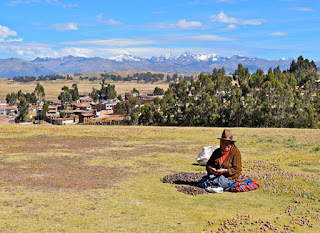What makes a characteristic become an identity?
 |
| Image by Matthieu Bourel (originally featured in New York Times What Is Identity?) |
Identity has been characterized in slight variations throughout history, stemming back to the Latin word identitas describing the status of being identical to something else. Due to its multitude of definitions and variations in use, scholars have continually sought (with incomplete success) to attach a common definition to the term. While certain explanations for the term are more recognized than others, it remains exceptionally variable. In practice, this means than intrinsic to most scholarly pieces on identity is a personal judgment on what makes a characteristic become an identity?
Comparison of Kanchan Chandra's What is Ethnic Identity and Does It Matter and Teri Caraway's Gendering Comparative Politics illustrate two very different approaches to the classification of identity characteristics. In her article, Chandra addresses the assessment of ethnicity in identity studies and defines ethnicity as a consideration of "descent-based attributes" (Chandra). While this definition seems relatively open-ended, Chandra incorporates a set of significant restrictions ranging from "ethnic identity must be impersonal" to "if one sibling is eligible for membership in an ethnic category at any given place, then all other siblings would also be eligible in that place" (Chandra 400). In contrast, Caraway's article seems to value breadth over restriction when considering gender as a characteristic of identity. Instead of arguing for a strict definition, Caraway discusses gender as a framework that can be applied to study.
Through this focus, the author introduces various possible methods of consideration, explaining that the wide-ranging considerations of gender, paralleled with intersectionality, culminates to its variations in study. Another common theme in Caraway's paper is the need for gender scholars to "push the boundaries of what the field considers to be political" (Caraway 172). This comes with the author's acknowledgment that gender has had limited recognition as a focus of political study in the past. This could be because most previous political research featuring gender was more focused on the binary attributes of male/female.
With an acknowledgment of these two approaches to defining attributes of identity, we can now return to the main question- what makes a characteristic become an identity? Given the analysis of both authors discusses above, I think this debate stirs up a deeper inquiry. WHO decides what makes a characteristic become an identity? At the risk of simultaneously oversimplifying and overgeneralizing even further, I believe the answer to this question can be reduced to one subject, the self. Whether this "self" is an individual defining their own identity, a local government considering the interests of certain constituent groups or the makers of a survey asking you to check certain boxes- identity is broken down into characteristics by us.
There are, of course, benefits and issues with this consideration. Still, it is made with the belief that once constraints are drawn on how identity has to be defined and what attributes can be considered, the term itself loses its purpose. Identity is a tool at our disposal for identifying our connection in the world, and thus it should not be constricted to the point where it becomes inaccessible. For this reason, I reacted more favorably to Caraway's approach. While it is evident that gender and ethnicity are very different characteristics of identity and Chandra was by no means erasing certain ethnic identities, I found Caraway's open-ended approach to the consideration of gender to be more accessible. If we set regulations on what characteristics "matter" or "count," I think there is a risk of splitting identity in a way that excludes instead of elaborates. The beauty of the plethora of characteristics that may assemble under identity is that it is not a zero-sum game. The acknowledgment of one identity does not need to come with the deletion of another.
I admit that in practice, this may be a naive perspective. The acknowledgment of one identity often does come with the recognition that one is not something else. This can be seen through the expression- "If everyone is family, no one is family." Further, history (and current times) show us that while we may desire that the acknowledgment of one identity does not come with the deletion of another, this is often not the case. Repeatedly, specific identity characteristics have been heard while others are silenced. The individual and the collective and the minority and majority groups have not existed in balance with one another.
This brings us back to the original question of representation- WHO decides what makes a characteristic become an identity? Consider the case of media coverage of a protest choosing to grant testimony to certain government officials while grouping others, both peaceful and violent, under the bounds of "the collective" - who is allowed to identify their own identity and who is grouped together? Whose voices are being heard?
 |
| intersectionality |
You could also look to Kimberlé Crenshaw's concept of intersectionality to see how particular layers of identity-based discrimination layer upon one another but remain oversimplified and misunderstood. This theory is seen in relation to scholarship, which acknowledges that "plaintiffs who face multiple disadvantages fare less well in civil rights litigation than do plaintiffs who suffer a single form of social disadvantage." A case commonly cited to explain this phenomenon of identity misrepresentation is one of "an employer who hires both white women and black men but refuse to hire black women because he stereotypes them as desperate single mothers" (Kennelly 1999). Here it is evident that "this stereotype is specific to black women" and "cannot be explained as the summed effects of racism and sexism" (Kennelly 1999). Laws protecting against racism and sexism often do not account for this summed effect leaving individuals in these situations as a disadvantage. Again, we see incomplete representation and consideration of identity. The answer to the question, who/ what decides what makes a characteristic become an identity, might, in this case, be the laws.
These two cases stress the importance of considering identity in collaboration with representation. In practice, we must continually ask- what/who decides what makes a characteristic become an identity? This may allow us to decipher what is being recognized or represented in different situations and what is not.
“Best et al. - 2011 - Multiple Disadvantages An Empirical Test of Inter.Pdf.” https://sites.lsa.umich.edu/rachelbest/wp-content/uploads/sites/208/2014/12/lasr463.pdf (June 11, 2020).
Best, Rachel Kahn, Lauren B. Edelman, Linda Hamilton Krieger, and Scott R. Eliason. 2011. “Multiple Disadvantages: An Empirical Test of Intersectionality Theory in EEO Litigation: Multiple Disadvantages.” Law & Society Review 45(4): 991–1025.
“Ethnic Identity.” https://wp.wwu.edu/trimble/ethnic-identity/ (June 10, 2020).
“Merlin_142464471_c013b551-55f7-45c6-83a8-7f0c982d66d0-SuperJumbo.Jpg (1410×1119).” https://static01.nyt.com/images/2018/09/02/books/review/02Giridharadas/merlin_142464471_c013b551-55f7-45c6-83a8-7f0c982d66d0-superJumbo.jpg?quality=90&auto=webp (June 11, 2020).
x


This is a fantastic post! I'm going to make your discussion of who defines identity even more complicated than distinguishing between self and others, by saying that not all "others" are the same. Within the societal forces defining identity we have in-group members (those who share identities with you), institutions (government), outgroup members (other citizens not sharing identities with you), and sort of a residual category of structural factors. There are usually mis-matches between self identification and each of these societal forces. One of the most overlooked is often this residual category. For example, governments create programs to distribute benefits that are often targeted toward disadvantaged groups. They come up with some definitions of what a disadvantaged group is. These definitions often make sense on their face, but run into challenges in implementation. In India, there are spots in schools reserved for both ethnic minorities and women and additional spots reserved for ethnic minority women. Unfortunately, each of these reservations was passed as a separate law and all of them conflict with each other. This enables universities to openly discriminate against one of these groups by interpreting the law in a certain way. It's a societal force for discrimination that is real, but came about through a convoluted series of events. How can we address these kinds of forces? Are they truly accidental?
ReplyDeleteAlso, intersectionality is super important and is almost never discussed in comparative politics. We will talk more about it throughout this course!